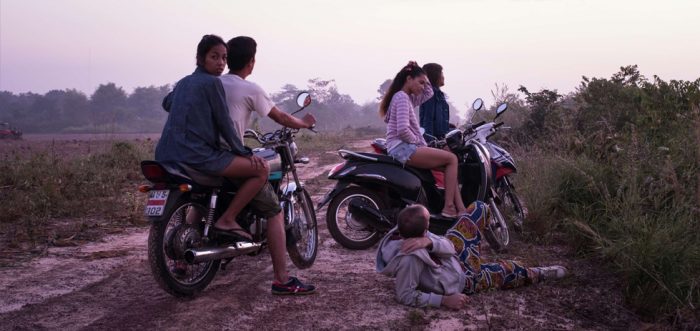
Katsuya Tomita’s stunning 2011 debut, Saudade, placed the familiarity of an environment and his deeply personal interaction at its constitutive core. As a filmmaker who had to fund much of his early career through his day job as a truck driver, his survey of Kofu, and the lifestyles and subcultures that defined the city, was an intimate portrait that emerged out of his own experience and relationship with the city. With that in mind, it was surprising when it was announced that the follow-up to Saudade would be set in Thailand. Tomita’s debut was built on a fundamental and thorough relationship to place and identity, which is something that such a follow-up couldn’t seem further away from on paper. This isn’t remotely how things pan out in Tomita’s three-hour odyssey. Bangkok Nites traverses Thailand’s geopolitical landscape, traces its fault lines, examines the scars of colonialism in the rural regions, and ties it masterfully to this same conception of Japanese identity that Tomita dissects in Saudade; with Tomita making one of the most complex and powerful films to emerge from Japan in the last decade.
From afar, it’s easy for Bangkok Nites to look like another film from a director travelling to a foreign country to shoot as a means to an end, however, Tomita’s film is an exception to such a rule; concerned with exploring the Japanese expat community, the country’s broader identity, the way in which Japan has related to Thailand in the past and present, and the way in which colonialism has positioned the two countries in the world. More than this, Bangkok Nites is a sequel to an idea that lingers from Saudade. “Thailand is paradise” is said by two different men in Tomita’s previous film, however, the statement isn’t explored at all in the film. In Bangkok Nites, it’s one of Tomita’s central concerns: to tear apart this idea of “paradise” and the scars, pain, and cyclical oppression that it’s built upon.
In the opening scene on Thaniya Road, Thailand,1 Bangkok Nights opens with two squabbling over drugs, one of them stating “I hate Japanese guys who rip off other Japanese guys.” Tomita’s opening scene is fascinated with the permutations of power and its abuse, as he explores the Japanese expat scene in the region, and the economic disparities that fuel it.2 This cartography of Bangkok’s nightlife serves as an entry point to the film, but is far from its core focus. Tomita throws himself into the mix as one of the central characters in the film, Ozawa, who has an on-off relationship with a worker in the district named Luck (Subenja Pongkorn), one of the most respected figures in the scene. For Tomita, this relationship shapes the trajectory of the film; exploring the complexities of the country, and the relationship it shares with his own.
Luck is quickly established as the most powerful and resilient character in the film, and she marks a broader trend in the cast. Tomita’s has a particular position as filmmaker, as a Japanese director exploring mutual identities between Japan and Thailand,with a specific focus on sex workers in Bangkok, and the strength of the film owes a lot to his ability to carefully navigate the community he represents with a great deal of respect, in both framing and characterisation. Throughout the film, Tomita articulates the uneven power dynamic in Thailand’s sex work as explicitly tied to the history of colonialism in the country. He highlights the way in which this manifests in specific regions in the country, and the cyclical nature with which it often operates in these considerations. At the same time, by immersing himself in the community, his characters are vivid, multi-dimensional, and portrayed with far more nuance than most films often manage in their more brazen approaches. Tomita goes to lengths to display their supportive interactions, with the female characters characterised as far stronger and perseverant than many of the more structurally-advantaged figures, who linger alongside the colonialism that Tomita also portrays.

Bangkok Nites is obviously far from a short film, however, there is little that feels overwrought or unnecessary. It’s the product of four years of immersion in the country from Tomita, both in the sociopolitical realm it navigates and the aesthetic elements that come into play as the film ventures into the Isan region, and eventually Laos. Bangkok is shot with saturation, bright lights, and remarkably colourful sets, while Isan is framed with more muted colours, paced much slower, and tied to a more mysterious atmosphere. The attention to detail reflects the process that informed the work. By soliciting advice from filmmakers that have frequently shot in Isan, including Apichatpong Weerasethakul, Tomita has managed to shoot scenes that reflect the aesthetic and cinematic history of the region.
Once Bangkok Nites enters the Isan province, there’s a shift that almost indicates a film-within-a-film, which is concerned with a markedly slower pace, an acknowledgment of the past trauma in the region, the spiritual aspects in this, and the aesthetics that have commonly depicted this in Thai films. Ozawa has visions that depict the haunted nature of the region, and visitations by the ghost of an old man, which precede a plunge into the underbelly of the region that broadens the film’s political context. The neon nightlife of Bangkok is stripped from the film, as it drifts into a different world.
These Isan sections offer the starkest commentary on the colonial impact in the region. The subtleties of Ozawa’s communication with many of the locals—such as the fact that English is the main language they have to communicate—explicitly focusing on this. Tomita features several French and English expats in the region, who are clearly there as a result of exploitation. At the same time, they’re depicted as disgusting, desperate, and disrespectful—achieved in their words, nuances, and expressions—as Tomita avoids gratuitous scenes and paints a clear portrait of the continuing colonialist impact in the area; an approach carried throughout the film.
Tomita hasn’t followed a typical pathway in Japanese cinema by any means. In an era where less people in the country are going to the movies, and studios are funding less adventurous works, Tomita’s self-funded Saudade and now Bangkok Nites have gone against the grain of every trend in its cinema sphere. Both of his features are three hours in length, and both have screened in the Concorso Internazionale at Locarno Film Festival. In the credits of Bangkok Nites, the special thanks for the film range from Apichatpong Weerasethakul to Abel Ferrera, and this breadth of influence is felt throughout the work. There’s an enormous scope—multiple countries, cities, towns, different approaches to aesthetics for these various regions, and an ensemble of characters to juggle—yet Tomita owns it, creating the strongest work of his career to date, and one of the most impressive films to emerge out of Japan in the last decade.
